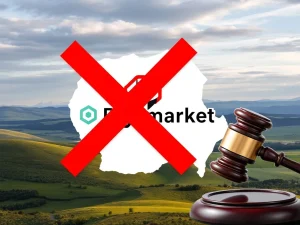Native Markets Victoriously Secures USDH Stablecoin Ticker on Hyperliquid After Intense Bidding War

The cryptocurrency world recently witnessed a captivating contest, culminating in Native Markets officially claiming the highly anticipated USDH stablecoin ticker on the Hyperliquid platform. This development marks a significant moment for the decentralized finance (DeFi) ecosystem, especially for those tracking innovations within the crypto exchange space. Native Markets’ success followed a heated bidding war, a process that captivated the crypto community and sparked widespread discussion.
Native Markets’ Triumph: Claiming the USDH Stablecoin Ticker
Native Markets, one of the prominent teams vying for the right to issue and manage Hyperliquid’s new US dollar stablecoin, USDH, has successfully secured its position. On Sunday, following a decisive community vote, the project officially claimed the USDH stablecoin ticker. This achievement signifies a major step forward for Native Markets and for the expansion of stablecoin options within the DeFi landscape. The bidding process itself generated considerable buzz, drawing attention from industry veterans and new enthusiasts alike.
Max Fiege, the founder of Native Markets, quickly outlined the strategic next steps via an X post. He confirmed the imminent deployment of the inaugural Hyperliquid Improvement Proposal (HIP) for USDH. Additionally, an ERC-20 token, leveraging the robust Ethereum network standard, will be introduced in the coming days. This methodical approach underscores Native Markets’ commitment to a stable and secure launch.
Fiege further detailed a phased rollout for the new stablecoin. Initially, a testing phase will commence, allowing for mints and redeems of up to $800 per transaction with an exclusive group. This controlled environment ensures stability and functionality before broader access. Following this crucial testing period, Native Markets plans to open the USDH/USDC spot order book, alongside uncapped mints and redeems. This structured launch aims to build confidence and ensure a smooth integration of USDH into the Hyperliquid ecosystem.
The Intense Bidding War on Hyperliquid
The race for the USDH stablecoin ticker was far from a quiet affair; it evolved into a closely watched bidding war within the crypto community. Speculation and anticipation ran high as various entities competed for this significant opportunity. Notably, Native Markets’ odds of winning surged dramatically, exceeding 99% on the prediction market Polymarket by Saturday. This spike occurred after synthetic stablecoin issuer Ethena strategically withdrew from the competition on Thursday, effectively clearing the path for Native Markets.
This intense competition for the USDH stablecoin ticker garnered significant attention from both the broader crypto community and industry executives. The process, however, was not without its controversies. Accusations of a potentially rigged selection process emerged, leading to broader reflections on the future direction of the entire stablecoin sector. The high stakes involved highlighted the increasing importance of stablecoins in the decentralized finance world. Understanding the dynamics of such a bidding war offers valuable insights into the competitive nature of the evolving crypto market.
The outcome of this bidding process, which saw established stablecoin providers, crypto firms, and payment companies lose out to a relative newcomer, sparked mixed reactions. Haseeb Qureshi, managing partner at venture capital firm Dragonfly, voiced concerns. He stated on Tuesday, “Starting to feel like the USDH RFP was a bit of a farce.” Qureshi added, “Hearing from multiple bidders that none of the validators are interested in considering anyone besides Native Markets. It’s not even a serious discussion, as though there was a backroom deal already done.” These comments reflect the underlying tension and scrutiny surrounding high-profile selections in the crypto space.
Source: Max Fiege
Future Implications for Stablecoins and Crypto Exchange Operations
The Hyperliquid USDH bidding war offered more than just a glimpse into a competitive selection process; it also sparked a profound debate about the future of stablecoins themselves. Mert Mumtaz, CEO of RPC node provider Helius, observed that the bidding war revealed a significant trend: stablecoins are increasingly becoming commoditized. This perspective suggests that the market is maturing, with less differentiation among basic stablecoin functionalities.
Mumtaz further speculated on a potential future where US dollar stablecoin ticker symbols might be abstracted away from the user interface. He envisioned a scenario where crypto exchange platforms would simply display a generic “USD” to front-end users. Behind the scenes, these exchanges would seamlessly manage the swapping of different stablecoins. This backend process would be invisible to the user, simplifying the experience significantly. Such an abstraction could streamline transactions and reduce user confusion, making stablecoins more accessible.
This shift towards commoditization and abstraction could have far-reaching implications for the design and user experience of decentralized exchanges like Hyperliquid. If users no longer need to differentiate between various USD-pegged stablecoins, it could lead to greater liquidity and efficiency across the market. The successful launch and adoption of the USDH stablecoin by Native Markets will undoubtedly contribute to these ongoing industry discussions and developments. The evolution of stablecoin usage patterns remains a key area of interest for market participants.
The integration of USDH on Hyperliquid represents a critical test case for new stablecoin models. Its performance, adoption rate, and the community’s trust will provide valuable data. As the crypto market continues to mature, the role of stablecoins in facilitating transactions and providing stability becomes ever more crucial. The journey of USDH, under the stewardship of Native Markets, will certainly be one to watch closely.
Native Markets’ official claim of the USDH ticker on Hyperliquid marks a pivotal moment. It not only highlights the intense competition in the stablecoin sector but also signals potential shifts in how users interact with digital dollars on crypto exchanges. The coming months will reveal the impact of this new stablecoin on the Hyperliquid ecosystem and the broader DeFi landscape.








